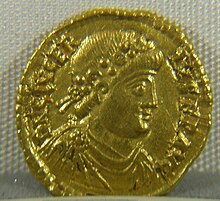Emperor Glycerius
| Glycerius | |||||
|---|---|---|---|---|---|
| Emperor of the Western Roman Empire |
|||||

Solidus of Emperor Glycerius
|
|||||
| Reign | c. March 3, 473 AD – June 474 AD | ||||
| Predecessor | Olybrius | ||||
| Successor | Julius Nepos | ||||
| Born | c. 420 | ||||
| Died | After 480 (aged 60) | ||||
|
|||||
| Religion | Chalcedonian Christianity | ||||
| Full name | |
|---|---|
| Flavius Glycerius |
Glycerius (Latin: Flavius Glycerius Augustus) (c. 420 – after 480 AD) was a Western Roman Emperor from 473 to 474. Elevated by his Magister militum Gundobad, Glycerius was rejected by the court at Constantinople and ousted by Julius Nepos. He later served as the bishop of Salona.
Sources on Glycerius are scarce and scanty. It is known that at the time of his elevation to the throne he was the comes domesticorum, the commander of the Imperial guard of the court at Ravenna. Previous to this posting, he had been the military commander in Dalmatia.
In 472, the Western Roman Empire was plagued by a civil war between Emperor Anthemius and his Magister militum (commander-in-chief of the army), Ricimer. Ricimer killed the Emperor and put Olybrius on the throne, but in a short time both Ricimer and Olybrius were dead. The Eastern Roman Emperor, Leo I the Thracian, tarried in choosing his successor, so the Germanic elements of the army, represented by the new Magister militum and Patrician Gundobad (a nephew of Ricimer's), elected Glycerius Emperor on March 3 or 5, 473 in Ravenna.
Little is known about the short reign of Glycerius. In his biography of St. Epiphanius, bishop of Pavia, Ennodius states that Glycerius made "many measures for the public good" but mentions only that he pardoned "the injury done to his mother by certain of his subjects at the petition of bishop Epiphanius." A single law issued by Glycerius survives, concerning simony, dated 11 March 473 and addressed to Himilco, the Praetorian Prefect of Italy. Ralph Mathisen speculates that Glycerius tried to stay on good terms with the Eastern Roman Empire. For most of his rule, Glycerius lived in Northern Italy, evidenced by the fact that the only coins issued in his name bear the mintmarks of Milan and Ravenna.
...
Wikipedia
